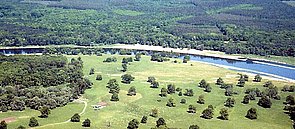Oak Meadows
The comprehensive design of the landscape in the Garden Realm started at a time when excessive clearances had emerged in the forests due to excessive use of the forest meadows. The forests primarily served as nutrition for domestic animals and game; they were a source of timber only in a secondary sense. As woods intended also as a source of food for livestock, their character was more reminiscent of meadows with mighty old common oak trees.
In addition to the useful value, Prince Leopold III Friedrich Franz von Anhalt-Dessau recognised the high aesthetic value of the solitary oaks. He was well skilled in the art of combining these park grounds and the manifold design elements with this special, open landscape, drawing on their similarity with a park character.
According to reports handed down, the oak trees in the meadows reached an average age of no more than 600 years. During the 19th century, when the age-related loss of solitary oak trees became increasingly clear, re-cultivation started on a large scale in the Dessau region.
The plantations (oak quarters) are protected according to the tried and tested methods using small fences. Starting from the Luisium Park, view cuts stretch across a meadow with old solitary oak trees to the former stables, where one can see new oak quarters with their young trees.
The solitary, broadly expansive oak trees on these meadows are valuable from a point of view of nature protection in addition to their aesthetic value, as they offer many animals, including extremely endangered species such as the stag beetle and almost extinct great Capricorn beetle a perfect habitat.
The biosphere reserve administration tends existing oak quarters. In view of the fact that oak quarters are mainly found in the floodplains and are often damaged during high water, this care is an important factor in preserving the oak meadows.

